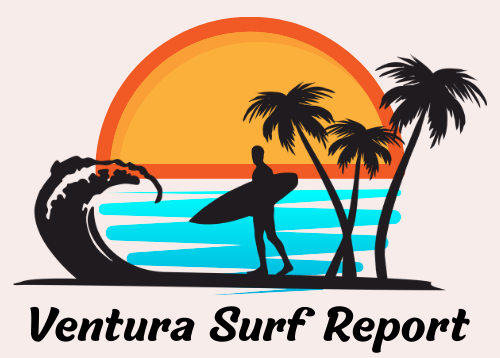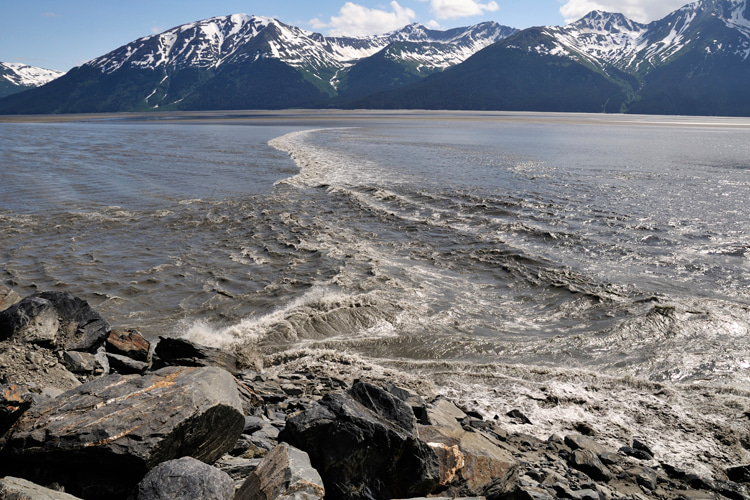
The Turnagain Arm is home to one of the world’s most famous tidal bores. And yes, it can be surfed against a stunning, heavenly-shaped backdrop.
Nestled beneath snow-capped peaks just south of Anchorage, Turnagain Arm plays host to one of the most dramatic tidal bores on planet Earth.
Twice each day, during extreme low and high tides, a rolling wall of water surges into this narrow, shallow inlet at speeds between six and 24 miles per hour (9.6 and 38.2 kilometers per hour).
If you’re a surfer and wonder how big these waves can get, you might be surprised to learn that they can reach heights from just a few inches to as much as 10 feet (three meters).
It all depends on how low the preceding low tide dips and how high the following tide climbs.
But let’s go into more details.

Why and Where It Happens
Cook Inlet boasts North America’s second-highest tides – swinging more than 35 feet (10.6 meters) – second only to the Bay of Fundy.
Turnagain Arm’s gently sloping, silty floor funnels these extreme tides into a raised front as they rush back in.
Knik Arm, just across the inlet, shares the same shape, but Turnagain’s wider mouth and mountain-lined shores give its bore extra drama.
The 1964 Alaska earthquake dropped the inlet floor by several feet, deepening channels and slightly reducing the bore’s former height, but it remains one of the largest in the world.
Earlier, in 1958, an earthquake triggered a series of extreme events that led to a megatsunami at the nearby Lituya Bay, in southeast Alaska.
One of them was a massive 1,720-foot (524 meters) high wave that peaked near the Gilbert Inlet and killed two people in a fishing boat.
This episode is still in the history books for the biggest wave ever documented.

Timing the Wave
Turnagain Arm’s bore tide can be predicted with high accuracy.
It all starts with knowing Anchorage’s low-tide times. Once you’ve got that figured out, it’s easy math.
The wave usually arrives 1 to 3 hours later, depending on your viewing point:
- Beluga Point: ~1 hour and 15 minutes after low tide;
- Indian Point: ~1 hour and 30 minutes;
- Bird Point: ~2 hours and 15 minutes;
- Girdwood: ~3 hours;
Nevertheless, it’s important to stress that wind can speed things up (westerly) or slow them down (easterly).
So, ideally, you should arrive at least 30 minutes before the expected bore.
On big days – around new and full moons or the spring and fall equinoxes – the bore swells with the roughly 27 feet (8.2 meters) of tidal difference needed to send a highly surfable wall of water down the arm.
For more precise data, check the tide times for Anchorage online.
Watching from Shore
The Seward Highway hugs the arm’s shoreline for 40 miles (64.3 kilometers), with five turnouts offering step-on access to the flats.
Beluga Point and Indian Point give closer, more intimate views.
Bird Point adds an interpretive panel – complete with Alaska’s Division of Parks and Outdoor Recreation “What a Bore!” poster – that explains the bore’s post-1964 history and moon-phase ties.
Bird Ridge offers a sweeping, distant panorama. It’s up to you to choose your favorite dry spot.
If you miss the bore at one turnout, simply drive on and catch it again down the line.

Surfing the Bore
A tight community of local surfers hauls boards across the glacial mud at low tide, paddling out to meet a wave they can ride for miles.
Faces of 5 to 10 feet (1.5-10 meters) are not unheard of when conditions align.
Wave riders reach speeds up to 15 miles per hour (24 kilometers per hour), but timing is everything – miss the wave’s lead, and you’ll drift miles away from your launch point.
Surfers use long, sturdy boards – often longboards and SUPs – and often tether themselves to small boats or kayaks for safety and a ride back.
Locals’ Tips and Rules
Local surfers have stuck a poster guide welcoming foreign surfers and stating the main riding guidelines.
To enjoy Turnagain Arm’s unique wave, everyone should respect the following rules:
- Respect the power of the tide – it’s our surf wave, and there are locals who live here;
- If in doubt, do not paddle out;
- If you are a beginner, please consider surfing further up at Gunmount for your safety and the safety of others;
- If you are a visitor, ask a local for advice on where to go that is best for you;
- Park respectfully and clean up after yourself and others who have been less thoughtful;
- If you are paddling down to catch the wave coming in, avoid surfers that are coming towards you;
- Be aware of the natural currents, mudflats, rocks, and ice, and please be conscious of where you enter and exit the water;
- Always aid another surfer in trouble and stay in control of your equipment;
- Please stay out of the way of riders on the wave and give some surfing space to one another;
- The surfer closest to the peak and curling wave has the right of way. Do not drop in or snake waves;
- Any violation of these rules and you will be asked to leave the water by a local;
- Remember: Give respect to gain respect here;
For more on the legendary Alaska tidal bore, we recommend a visit to the Discovery Center’s Water Zone at the Anchorage Museum.

Hazards and Don’ts
The silty mudflats that stretch for hundreds of yards can trap the unwary in quicksand-like silt.
Several fatal drownings and hypothermia deaths have occurred when walkers became stuck and couldn’t escape the incoming tide.
Also, never venture onto the flats unaccompanied, untrained, or without proper gear.
Stay on solid ground at least 50 yards back, heed posted warnings, and watch from elevated pullouts.
Surfers should wear drysuits or thick wetsuits, carry personal flotation devices, and always paddle with a partner.
Don’t get fooled. The wave seems relatively easy to master, but the whole traveling energy could be overwhelming.
Words by Luís MP | Founder of SurferToday.com


Leave a Reply